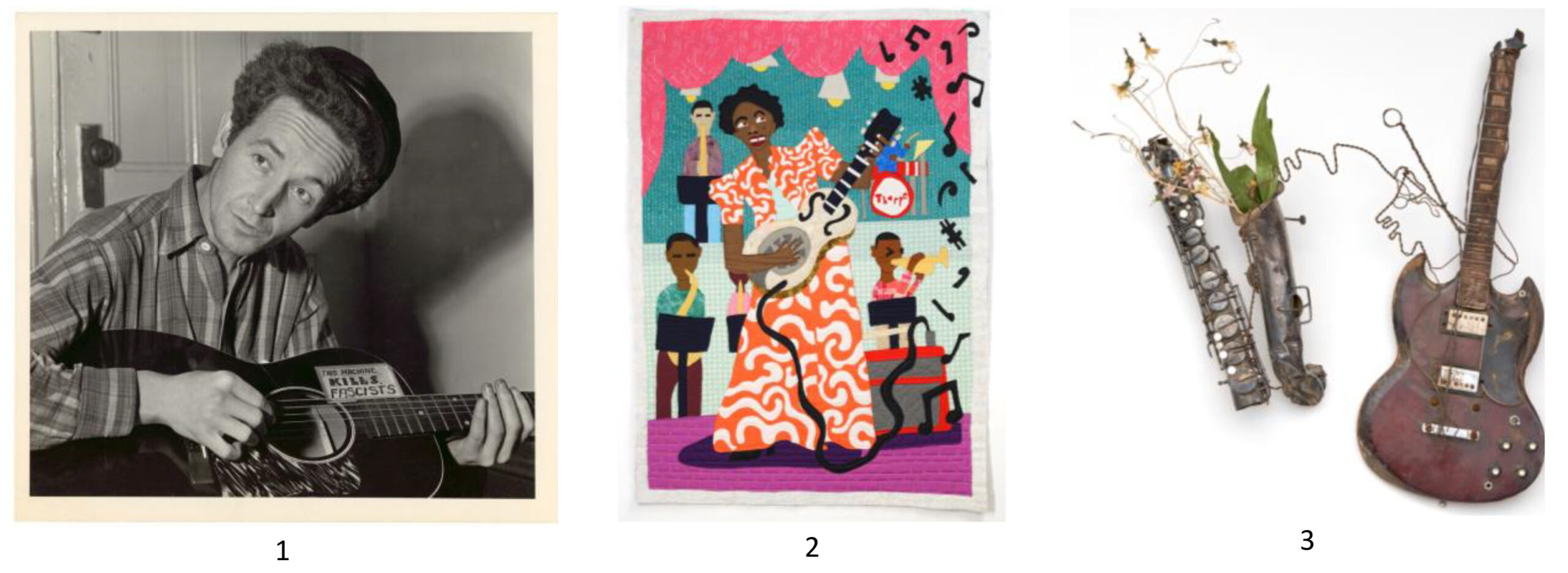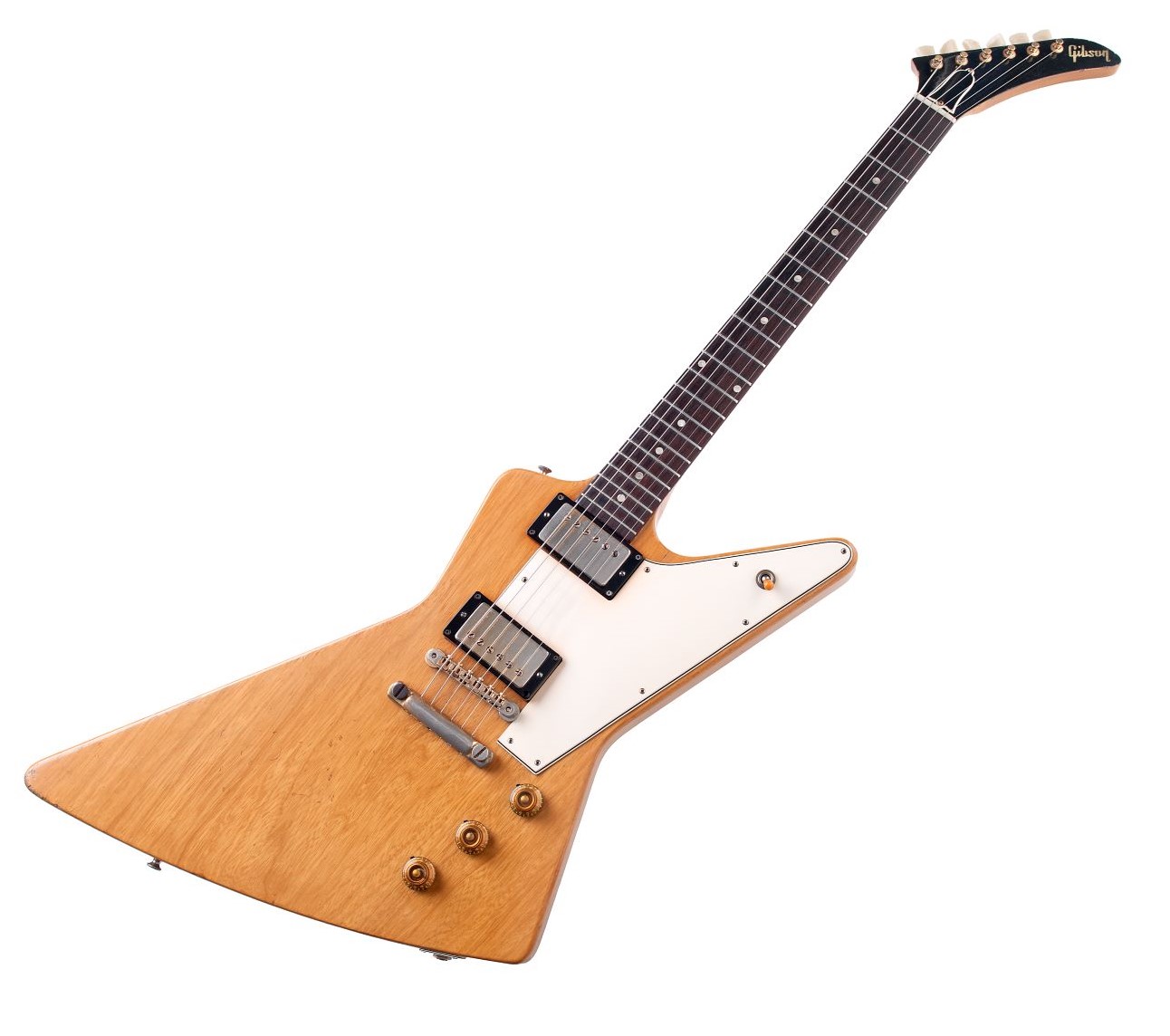Storied Strings: The Guitar in American Art
May 26–August 13, 2023

NASHVILLE, Tenn. (April 12, 2023)—The Frist Art Museum presents Storied Strings: The Guitar in American Art, the first exhibition to explore the instrument’s symbolism in American art from the early nineteenth century to the present. Featuring 125 works of art as well as thirty-five exceptional instruments, Storied Strings will be on view in the Ingram Gallery from May 26 through August 13, 2023. The companion photography exhibition Guitar Town: Picturing Performance Today, which celebrates Nashville’s diverse music scene, will be presented concurrently in the always-free Conte Community Arts Gallery from April 21 through August 20, 2023.
Organized by Dr. Leo G. Mazow, the Louise B. and J. Harwood Cochrane Curator of American Art at the Virginia Museum of Fine Arts, Storied Strings explores fascinating connections and contrasts that show how guitars figure prominently in the visual stories Americans tell about themselves. Works by artists such as John Baldessari, Thomas Hart Benton, Lonnie Holley, Dorothea Lange, and Annie Leibovitz and seminal instruments by Fender, Gibson, and C. F. Martin & Company show how guitars have served as symbols of American history, cultural attitudes, identities, and aspirations. For the presentation at the Frist, notable instruments and other artworks drawn from Middle Tennessee collections will be on view, reflecting Nashville’s internationally renowned status as Music City, a mecca for outstanding guitarists and socially impactful music.
Storied Strings is organized thematically into sections including “Leisure, Culture, and Comfort: 18th and 19th Century America;” “Amateurs and Professionals;” “Hispanicization;” “Blues and Folk;” “A Change is Coming;” “Iconic Women of Early Country Music;” “Cowboy Guitars;” “The Visual Culture of Early Rock and Roll;” “Personification;” and “Aestheticizing the Motif.” Linking these disparate themes is the premise that the malleable image of the guitar has long enabled artists and their human subjects to address a wide range of themes and stories that otherwise would go unexamined.
The exhibition begins with early depictions of people playing guitars at home, showing the cultivated tastes of middle- and upper-class families in the late eighteenth and nineteenth centuries. “From the first known American drawing of a guitar—Thomas B. Middleton’s Friends and Amateurs in Musick of 1827—the guitar in the nineteenth century often symbolized gentility, comfort, and easy camaraderie,” writes Mazow.
A selection of classic Martin guitars, showing the importation of guitar-making techniques from Europe to the United States, is included in the following section, “Amateurs and Professionals.” A highlight of this section is Thomas Hicks’s painting The Musicale, Barber Shop, Trenton Falls, New York (1866), a rare depiction of a nonsegregated musical group made just after the Civil War. The sections Hispanicization and Hawaiiana reveal how guitars have been used to portray certain musical styles as “exotic” for white American audiences and romanticize their points of origin.
“Iconic Women of Early Country Music” features photographs of Lulu Belle, Maybelle Carter, Loretta Lynn, and Kitty Wells, as well as associated objects, with videos of several of these musicians in performance. Another section showcases cowboy motifs, with videos of Roy Rogers, Tex Ritter, and others playing western-tinged country music in early-to-mid 20th century. Highlights of this section include Thomas Hart Benton’s final study for his massive painting The Sources of Country Music, a permanent fixture at the Country Music Hall of Fame and Museum, just down the street from the Frist. This section acknowledges the origins of the cowboy look, as well as showing its expanded legacy in today’s country by LGBTQIA+ musicians such as Orville Peck.
“The guitar’s role in giving voice to people across America is acknowledged in artworks and recordings that show the cultural impact of blues and folk music, born of the injustices, hopes, sorrows, and joys experienced by poor and working-class people, especially people of color and migrant workers,” writes Frist Art Museum chief curator Mark Scala. “Over a third of the works in the exhibition are by Black artists or depict Black musicians. An extraordinary example is Romare Bearden’s luminous collage Three Folk Musicians (1967) which shows the merger of two worlds—the European guitar and the African banjo, a synthesis that is still at the core of much Americana music.” The social message in this section is clear—whether in Elizabeth Catlett’s I Have Given the World My Songs (1947), a searing depiction of a Black woman playing guitar in front of the scene of a lynching, or Danny Lyons’s photograph of Bob Dylan at the Student Nonviolent Coordinating Committee (SNCC) office in Greenwood, Mississippi, the guitar can be seen as a symbol of resistance to an uncaring world.
From paintings of street buskers to photographs of Dolly Parton on a tour bus, the section Making a Living looks at how the guitar’s affordability and portability have made it the people’s instrument, allowing for a modest living or great financial success. The close, personal attachment many players have to their instrument is examined in the section “Personification,” with subjects cradling or hugging their instruments like children, lovers, or even extensions of their own bodies.


Iconic electric guitars such as a 1953 Fender Telecaster and a 1958 Gibson Explorer—some of which were played by the likes of Keith Richards and Eric Clapton—shine in the section titled “The Visual Culture of Early Rock and Roll.” The real star, however, is Sister Rosetta Tharpe, the Godmother of Rock and Roll who influenced Elvis Presley and others in the 1950s; she reigns in a striking quilt by Michael C. Thorpe and a video performance installed nearby.
The final section, “Aestheticizing the Motif,” explores the inherent beauty of guitars in works like John Baldessari’s hand-painted print collages and Kaki King’s video performance of her song “Surface Changes,” which shows an innovative combination of musicianship and visual art for the 21st century.
Several key objects in the exhibition are on loan from the Country Music Hall of Fame and Museum, and throughout the summer, a series of programs featuring live performances and exhibition tours will be offered by the neighboring museums. Reciprocal admission for Frist and CMHoF members will be offered on select dates. More details will be posted on FristArtMuseum.org.
Programs
Thursday, May 25
Curator’s Perspective: Storied Strings Presented by Dr. Leo G. Mazow
6:30 p.m.
Auditorium
Free; first come, first seated
This illustrated lecture introducing Storied Strings: The Guitar in American Art will explore the guitar’s symbolism in American art from the early 19th century to the present day, demonstrating the instrument’s capacity to denote myriad social topics—from race and ethnicity to class and gender—while reflecting the American music industry itself.
Dr. Leo G. Mazow, Louise B. and J. Harwood Cochrane Curator of American Art, has been at the Virginia Museum of Fine Arts since 2016. A specialist in 19th- and 20th-century American painting and cultural history, he received his PhD at the University of North Carolina at Chapel Hill. From 2010 through 2016 he was an associate professor of art history at the University of Arkansas in Fayetteville. From 2002 through 2010 he was curator of American art at the Palmer Museum of Art at Penn State University.
Exhibition Credit
Storied Strings: The Guitar in American Art is organized by Dr. Leo Mazow, curator of American Art at the Virginia Museum of Fine Arts.
Image Credits
1. Al Aumuller. Woody Guthrie, half-length portrait, facing slightly left, holding
guitar, 1943. Gelatin silver print; 8 1/8 x 8 6/8 in. Prints and Photographs
Division, Library of Congress, Washington D.C.
2. Michael C. Thorpe. Sister Rosetta Tharpe, 2021. Fabric; 46 x 33 1/4 in. Private
collection, courtesy of LaiSun Keane, Boston
3. Lonnie Holley. The Music Lives after the Instrument Is Destroyed, 1984. Burned musical instruments, artificial flowers, and wire; 33 x 36 x 3 in. Souls Grown Deep Foundation
Supporter Acknowledgment
Platinum Sponsor: HCA Healthcare/TriStar Health
Hospitality Sponsors: The Union Station Nashville Yards and Grand Hyatt Nashville
Spanish Translation Sponsor: Center for Latin American, Caribbean, and Latinx Studies at Vanderbilt University
Education and Community Engagement supporter: Windgate Foundation
The Frist Art Museum is supported in part by The Frist Foundation, Metro Arts, the Tennessee Arts Commission, and the National Endowment for the Arts.
Connect with us @FristArtMuseum #TheFrist
FOR ADDITIONAL INFORMATION
Buddy Kite: 615.744.3351, bkite@FristArtMuseum.org
Ellen Jones Pryor: 615.243.1311, epryor@FristArtMuseum.org
